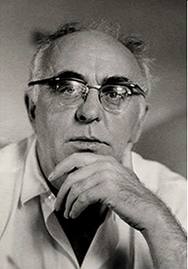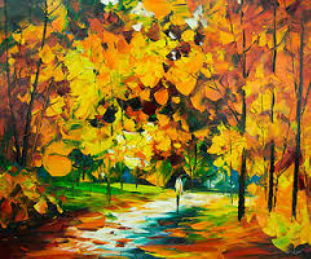 I find this style of art to also be very poetic. It is expressive of a person's name, but it originated from objects found all around us. By combining these two styles, it created a visually stimulating work of art. Poetry is also very stimulating, thus I also feel that this is poetry.
This recent pop song demonstrates poetry because of it's lyrics and deep meaning. The melody speaks to a listeners heart, even when the meaning of the words seems to be unclear. The meaning behind the words speak about the errors of our society. It focues on the idea that the people in the media are nothing like the people watching or listening. They are not represenative of society.
 I find this piece of art to also be poetic. The colors are very vibrant, much like the imagery of Hass' writing. Each time I look at this painting my eye catches something else. I find this to be a similar action to poetry because after each read, I notice something else to be more important than last time. It takes a lot of thought to decifer what the meaning of this piece of art is which is simliar to much of Hass's writing.
The lyrics in this song begin with the relationship between a son and an unknown chorus. It travels along for a long story, lasting roughly seven minutes. In this way, it represents a prose poem and, I think, it is in fact a free verse prose poem. Listen to this song and decide for yourself if you think this is truely found poetry.
Robert Hass is an eco poet, which initially drew me into his writing. However, it is his creative and vivid style of writing that kept me intrigued. My partner, Peyton, is also researching an eco poet William Henry Davies. We both enjoy the outdoors and have found that our eco poets reflect our own emotions and love towards nature. Although Davies does stray from eco-poetry, all his poems reflect love and beauty. From my research, I have found Hass to be a dynamic writer and one that has many avenues to explore. Robert Hass was born in 1941. In recent years, Hass has published many poems including "Faint Music," a poem about the sound of nature. He was written both poetry and prose, which is thoroughly described on the Poetry Foundation ( http://www.poetryfoundation.org/bio/robert-hass). The Dunbar library has several of his collection available including The Apple Trees at Olema, Time and Materials, and What Light can Do. The Wright State Libraries also provides several interviews via JSTOR ( http://www.jstor.org/action/doBasicSearch?Query=Hass%2C+Robert&acc=on&wc=on&fc=off). On this link, there are also reviews of his work and collections of his poetry.
| Denise Levertov is associated with the Black Mountain School of Poetry. She writes very descriptively with her poems, much like Yusef Komunyakaa, who is part of the Jazz Poetry. The context of these two poet's subjects are vastly different. Levertov often writes about everyday circumstances, like in Aware, or events that happen in a quick-paced time frame. Komunyakaa often writes about war and experiences that happen. These types of poems are very descriptive, where he goes back several times to reinforce a specific idea or point. I think Levertov makes her point and moves on through her poems.
There are several similarities that I have noticed, too. Both poets make great use of space. They mix up the visual style of their poems, which keeps readers engaged. Also, the concepts they write about are easily grasped and understood by the audience. Levertov and Komunyakaa use free verse.
I, personally, feel that Komunyakaa is an easier read because of the subjects he chooses to write about. I feel that I can relate more to the conflicting feels that a war zone would create than how a tree makes sounds. Personification like in the poem Aware is a common devise of Levertov's that adds depth and difficulty to her poems. Others may feel that Komunakaa is harder because of his war oriented poems. This creates a stand off. Their uniqueness creates enough diversity that many readers will be fascinated with these two great poets.
| AWARE by Levertow
When I found the door
I found the vine leaves
speaking among themselves in abundant
whispers.
My presence made them
hush their green breath,
embarrassed, the way
humans stand up, buttoning their jackets,
acting as if they were leaving anyway, as if
the conversation had ended
just before you arrived.
I liked
the glimpse I had, though,
of their obscure
gestures. I liked the sound
of such private voices. Next time
I'll move like cautious sunlight, open
the door by fractions, eavesdrop
peacefully. |
 His exaggerated used of quick quick, quick, more, more, more (388) was an easy read and had appropriate comma usage, compared to the rest of the writing, where I felt like a seven year old sounding out words. I also liked his blunt example “the HEAD, by way of the EAR, to the SYLLABLE/ the HEART, by way of the BREATH, to the LINE.” I actually agree with this point, too, because how else, when reading poetry, are you able to so closely connect mentally with the words and feel them resounding inside you at the same time? However, I feel like he should have simply said this from the beginning because it took me several times of rereading portions like “It would do no harm, as an act of correction to both prose and verse as now written, if both rime and meter, and, in the quantity words, both sense and sound, were less in the forefront of the mind than the syllable, if the syllable, that fine creature, were more allowed to lead the harmony on” to fully understand the point he was trying to make about the relationship between line and syllable. Throughout the entire piece portions like the above came up again and again where I felt lost and that I was only reading the words, not comprehending. After working thorough it, though, he did make several valid points about poetry.
I also found his comparison of the typewriter to stanzas very compelling. It was a totally fresh outlook on the use of commas and spaces for poets. Musicians have the ability to put in breath marks, whole notes, eight notes, or even a sixteenth rest to convey their emotions or mood of the song. So on page 393 when
he talks about how this is now accepted and used in poetry, it made more sense to me as to why it’s important.
 I thought she did a great job of setting up this article in a way that
instantly made people want to read more on a subject that might scare people away. By starting off with her college years, I was quick to relate to her stories that followed about finally finding something she liked and a group to hang out with because I’m the same age. Then, she masterfully transitioned to her job and how she became a poet. The misunderstanding she experienced is the same look I get from my friends when I say “I love that poem.” (I don’t even follow poetry, and I get blank stares). In this situation, Arlene says, “I’d move on to less freakish subjects.” I was sad to hear that she believed her profession wasn’t accepted by her friends, that they thought it was beyond weird. However, I think she was able to beautifully sum up her thoughts about “freakish” things in her last paragraph. It is freaky that we watch pop-tart cats flying around and dance to who-knows-what-they’re-saying day in and day out. This comparison between two people’s interests and how, in a way, each
group thinks the other’s like is freaky. It sheds a better understanding on the way a poet thinks about things that I had never considered in that way before.
|





